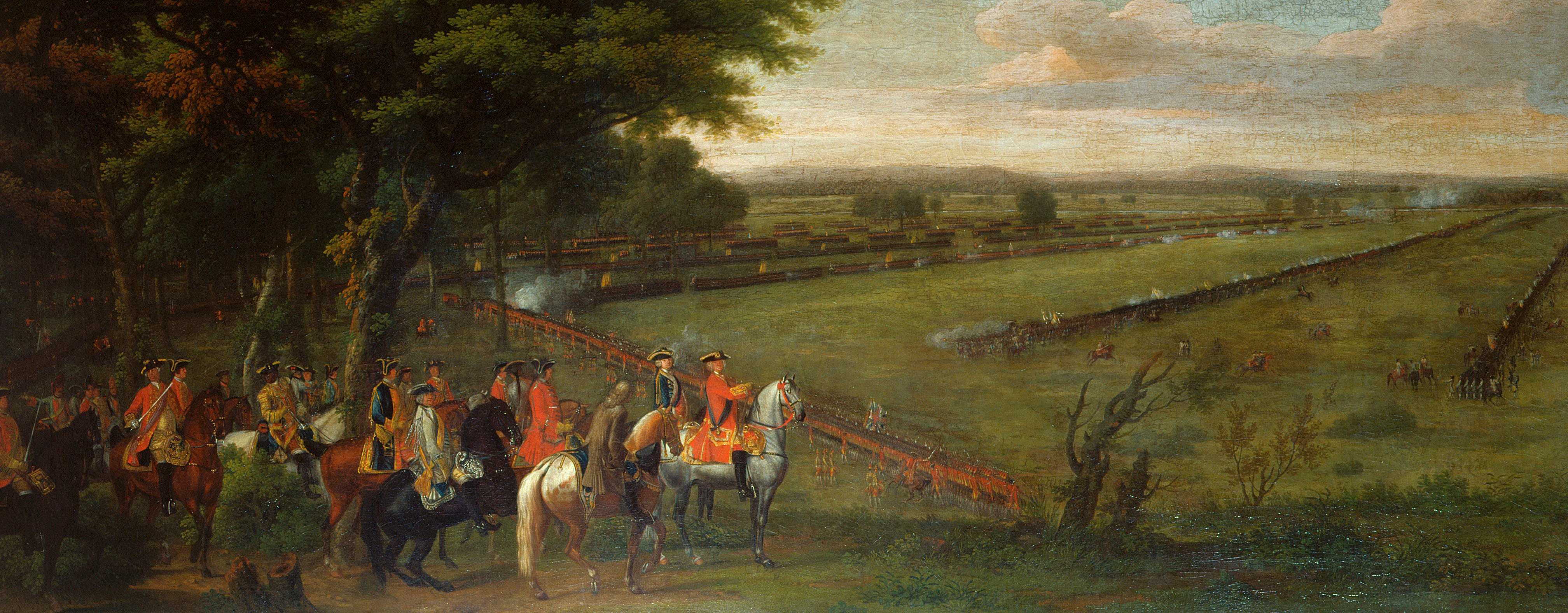
War of the Austrian Succession (1740-8)
Includes much of the mapping collected by William Augustus, Duke of Cumberland, as Captain General of the British army
View of Diegem, 1745 (Diegem, Flanders, Belgium) 50°53'50"N 04°26'00"E
1745 or laterPencil, pen and ink on paper | Diameter: 25.6 cm (image diameter) | RCIN 729140
This circular panorama is a topographical anamorphic image, ‘Fish-Eye’ or cylindrical view, belonging to the genre of distorted images, made famous by Hans Holbein's The Ambassadors (1533) which became popular in the seventeenth and eighteenth centuries. The topographical images were always taken from a height, as in this example, from the steeple of Diegem church. The church of Sainte Catherine and Saint Cornelius forms the centre point of this drawing, and is accurately represented in plan. (Hyde 1987, p.34-39; Baltrusaitis 1977.) The gridded preparatory sketches for this drawing, from which the circular view would have been constructed, do not appear to have survived.
The little village of Diegem was Cumberland's headquarters in the summer of 1745. It was from here, at the end of July, not yet knowing that the Young Pretender, Prince Charles Edward Stuart, had arrived at Arisaig (on the west coast of Scotland, west of Fort William) on 25 July, that Cumberland wrote stressing his desire to return to England for ‘it would be horrid to be employed abroad when my home was in danger’. Cumberland's draftsman, Schultz, must have climbed to the steeple of Diegem church which forms the central point of this unusual view of the army's tents, stretching out on either side of the village. The spires of Antwerp can be seen about 25 miles to the north-west, and Brussels, about five miles distant, appears on the south-west horizon. The present-day view would include Brussels airport, about three miles north-east of Diegem.
Condition: six fold lines; untidily trimmed to edge of image; surface dirt.
George Augustus Schultz (active 1734-49) (draughtsman)
Subject(s)
Army-Allied army (War of the Austrian Succession, 1740-48)Prince William Augustus, Duke of Cumberland (1721-65)Watermark: Cropped: fleur-de-lys in shield, a ‘4’ suspending the letter V below
Mark, stamped: 471
Condition: six fold lines; untidily trimmed to edge of image; surface dirt
25.6 cm (image diameter)
Manuscript title:
A Circular View of the Horizon from the Steeple of the Church of DIEGHEM , with the Situation of the INCAMPMENTS of the Army of the ALLIES, Commanded by His Royal Highness The DUKE of CUMBERLAND, From the 14.th July to the 2.d of August, 1745, N.S. (The Head-Quarters at Dieghem & Saventhem). [around drawing, inside border]
Annotations:
George III heading: Encampment at Dieghem 14 July - 2 Aug.t 1745.
Other annotations: none.
George III catalogue entry:
Dieghem. A drawn circular View of the Horizon from the Steeple of the Church of Dieghem with the situation of the Encampments of the Army of the Allies commanded by the Duke of Cumberland, from the 14.th July to the 2.d Aug.t 1745.
Subject(s)
Diegem, Flanders, Belgium (50°53'50"N 04°26'00"E)
Bibliographic reference(s)
J. Baltrusaitis, Anamorphic art, Cambridge, 1977
R. Hyde, 'London as seen through a fish's eye', The Map Collector, 39, Summer 1987
Flight and the artistic imagination Compton Verney June-September 2012 (exhibit no.23). [The view is also published in the exhibition catalogue: Sam Smiles, Flight and the artistic imagination (2012), p.43.
Page revisions
23 May 2024
Current version






